I was fortunate to meet an experienced senior who started with 10,000 and became worth over 100 million. They once told me what it felt like to gain insight into trading, and now I have also come to understand that feeling. The greatest benefactor in life is not finding money or winning the lottery, but one day meeting someone who breaks your original thinking and elevates your perspective, leading you to a better stage. Life is the same; cognition determines wealth, and underlying logic determines the superstructure!
Before gaining insight, it feels as difficult as climbing to the sky; after gaining insight, it becomes as easy as flipping a hand. Many stock market experts find trading cryptocurrencies simple after understanding the principles, while many retail investors believe that those who profit from trading cryptocurrencies have gained their skills through countless hours of study and numerous losses.
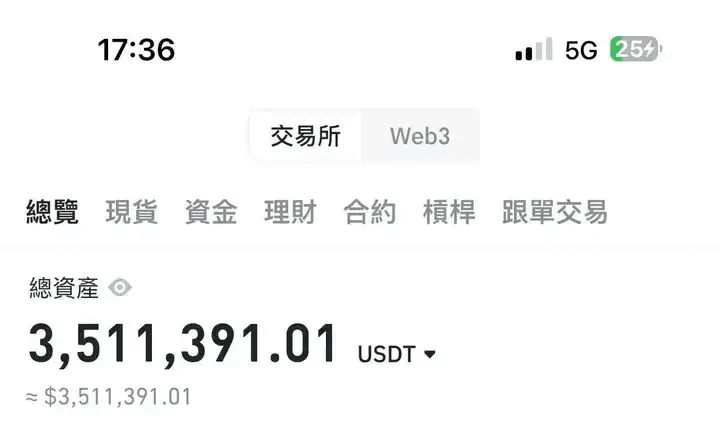
While I may not be a top trader, I have been steadily profitable for 10 years. I am willing to share my trading mindset:
In trading, you don't always need a highly complex or professional method to achieve success. Instead, you only need an effective strategy. Utilizing one of the oldest and simplest trading tools—the Moving Averages—might be a good start.
If you are a scalper or use other short-term strategies, using moving averages in a 15-minute chart is highly recommended. Among them, the 20EMA (Exponential Moving Average) is the most useful moving average in the 15-minute chart, as the price follows the moving average trend most accurately over multiple days. In other words, you can easily identify trends through it.
How does the 20EMA strategy work?
The main advantage of the 20EMA trading strategy is that even novice traders can easily get started. The only tool you need is the 20EMA, and it is applicable to any currency pair and any time frame.
In a downward trend, the overall expectation is for prices to decline. However, at some point, you will see the price change direction to test the 20EMA line. If the downward trend is strong enough, the 20EMA will push the price back down. This phenomenon is called a 'pullback,' and it may occur once or several times until the 20EMA is effectively broken.
Therefore, the core role of the 20EMA strategy is to act as a 'rebound line' for candlesticks. As a trader, you should wait for and utilize the moment when the price pulls back to the 20EMA line.
Here is a key detail to note: you only need to focus on one very specific candlestick—the first one that returns to and touches the EMA line after the price has deviated from the 20EMA for a period of time. Remember, if the next candlestick continues to move closely along the EMA line, it is not a good signal. Once you capture the correct signal, it is a good time to open a position.
For example:
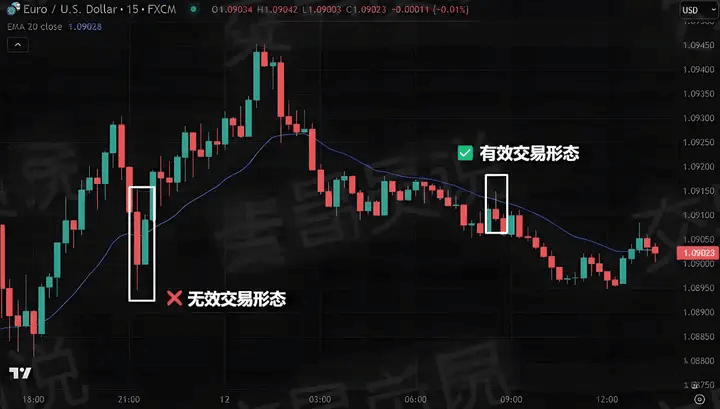
The basic principles of the 20EMA strategy are as follows:
When the closing price is above the 20EMA, the market is in an upward trend; when the closing price is below the 20EMA, the market is in a downward trend.
The first candlestick that touches the 20EMA after a trend changes direction is called the signal candlestick. You only need to focus on this candlestick, as your entry position depends on its highest and lowest points.
In an upward trend, you should set your buy stop-loss order 1-2 points above the highest point of the signal candlestick. If the next candlestick does not trigger your order, you should cancel it.
Conversely, in a downward trend, you should set your sell stop-loss order 1-2 points below the lowest point of the signal candlestick. If the next candlestick does not trigger the order, you should cancel it.
In long trades, the stop-loss should be set a few points below the lowest point of the signal candlestick (at least 5-10 points, depending on the time frame you are using); in short trades, the stop-loss should be set a few points above the highest point of the signal candlestick.
Here is an example of establishing a short position based on the previous chart:
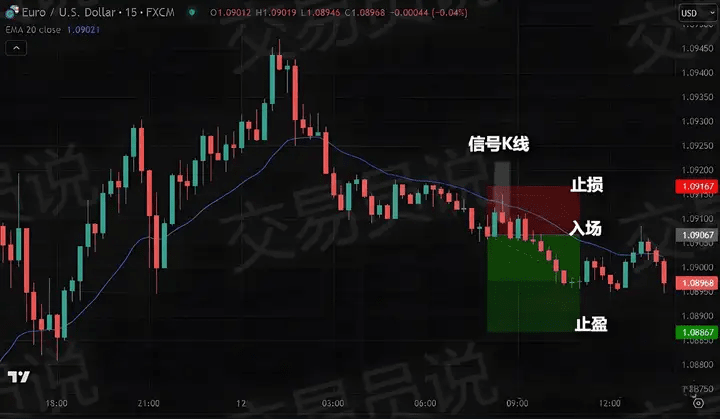
In the above chart, the lowest point of the signal candlestick on the EUR/USD 15-minute chart is 1.09087, so the sell stop-loss order is set 2 points below that. The next candlestick continues to fall, triggering the order at 1.09067. According to the rules, the stop-loss is set 10 points above the signal candlestick, at 1.09167. As for the take profit, this example uses a 1:2 risk-reward ratio, so the take profit is set 20 points below the entry price, at 1.08867.
Use daily charts to identify major trends.
You definitely don't want to recklessly enter the market when the trend is unclear and risk losing money, which is why some traders choose to filter the market by switching to other time frames. They hope to identify the trend in advance and ensure that it is strong enough. Once they confirm the price's direction on the daily chart, looking for entry opportunities on the 15-minute chart becomes much easier.
What should I do?
First, to identify trends, you need to set several rules on the chart. The goal is to determine the direction of price movement. Don't worry, these rules apply to both upward and downward trends and are effective across different time periods.
Ensure the price has been continuously rising or falling for several days, and at least one higher low (HL) has appeared in an upward trend, while at least one lower high (LH) has appeared in a downward trend.
In an upward trend, the 20EMA line should present an upward angle of 2 o'clock or steeper; in a downward trend, the 20EMA should present a downward angle of 4 o'clock.
In an upward trend, the price should significantly break through the resistance level; in a downward trend, the price should significantly break below the support level.
After this, switch to the 15-minute chart and focus on the potential buying conditions in the following two upward trends:
1. Breakthrough of support/resistance on the daily chart.
If the price clearly runs along the 20EMA, it means it is at an ideal trading position.
2. Significant fluctuations in support/resistance areas.
This situation is relatively safer because the price has confirmed its momentum and continues to run in the expected direction. Therefore, when the price touches and stabilizes near the 20EMA, it is a good time to enter.
How to use the 20EMA to find high-quality entry points.
Using the 20EMA (Exponential Moving Average) to determine a high-quality entry point is relatively simple. First, identify the trend, find support and resistance, and then enter when the price retraces to these levels.
1. Identify the trend.
The process of using the 20EMA indicator to identify trends is quite straightforward. You only need to observe the position of the EMA line relative to the current price movement.
If the EMA line is below the current price, it indicates an upward trend.
Conversely, if the EMA line is above the current price, it indicates a downward trend.
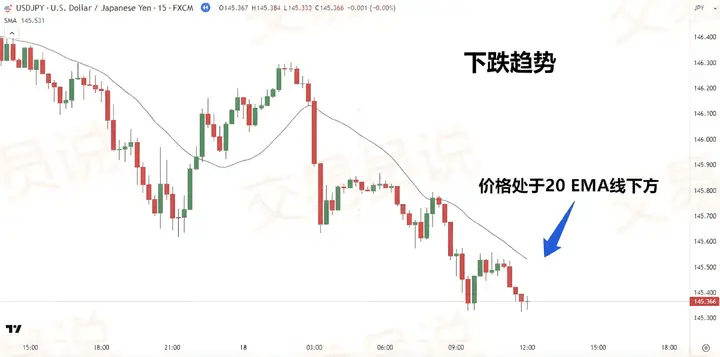
2. Look for support or resistance.
Once you identify the current trend, the next step is to identify important support or resistance levels. As previously emphasized, we focus on the dynamic support and resistance coming from the 20EMA line.
In a downward trend, the 20EMA line acts as a resistance level.
Conversely, in an upward trend, the 20EMA line acts as a support level.
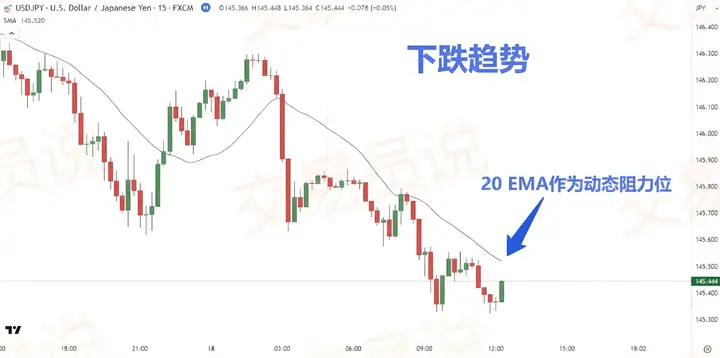
3. Wait for a pullback.
Next, you need to patiently wait for the price to pull back to support or resistance levels or close to the 20EMA line.
This stage is very important and is often overlooked by many novice traders. They may think that once the trend direction is clear, they can immediately enter the trade.
However, in practice, even when the trend direction is clear, we still need to patiently wait for a pullback. This waiting time is crucial for optimizing the risk-reward ratio of trading setups.
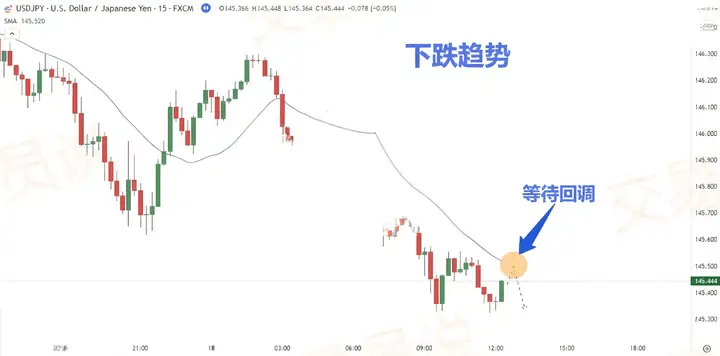
4. Entry confirmation.
There are two ways to confirm entry: using price action or technical indicators.
Price action confirmation: Observe chart patterns or candlestick formations. Common chart patterns include double tops/bottoms, head and shoulders tops/bottoms, triple tops/bottoms, etc. Common candlestick patterns include engulfing patterns, pin bars, inside bars, etc.
Technical indicator confirmation: Tools such as stochastic indicators, RSI, and MACD can be used.
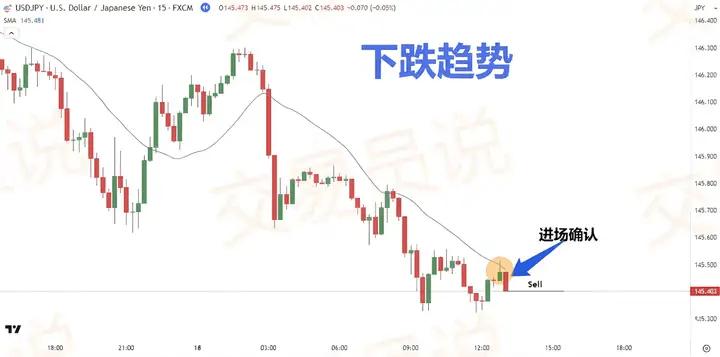
When using this trading strategy, be sure to focus on the following aspects:
1. Only enter the market when it is trending.
Entering trades when the market is in a clear and established trend can significantly increase the probability of trading success. The price is more likely to continue in the original direction, which benefits traders in following existing momentum. In contrast, attempting to trade in a non-trending or oscillating market may result in unpredictable price movements and unfavorable trading outcomes.
2. Avoid counter-trend trading.
Counter-trend trading carries higher risks. Counter-trend trading means that traders are essentially betting that the market will reverse its current direction, which requires very precise timing and strong reversal signals as a basis.
3. Enter during active trading hours.
Active trading periods usually coincide with the overlap of major markets, such as when the London market and New York market are both open. Trading during these periods offers better opportunities because the volume and price volatility are relatively higher, leading to tighter bid-ask spreads, less slippage, and better execution quality.
Conversely, trading during low activity periods (such as the Asian session, weekends, or holidays) may face larger spreads and lower liquidity, making trade execution more difficult.
Is the 20EMA suitable for intraday trading?
The answer is yes. The 20EMA is applicable not only to scalping but also to intraday trading. However, in intraday trading, you usually need to wait for specific patterns to appear before entering and, once you find such a pattern, confirm it with support and resistance levels. This pattern is actually quite easy to identify.
You should see a strong upward or downward trend in the first two hours after the market opens, followed by a price pullback to the 20EMA. Remember, to maintain the effectiveness of this strategy, you also need to confirm the trend direction on higher time frames. If the trend in the higher time frame aligns with the earlier movement, the likelihood of price reversing near the 20EMA is very high.
Will the 20EMA strategy fail? Backtesting results tell you.
Like any other trading strategy, the 20EMA is not perfect and may fail. Sometimes, the price may indeed reach support or resistance levels but still consolidate; the price may even ignore the 20EMA and fluctuate back and forth. If you encounter this situation, it's best to pause trading and patiently wait for the next opportunity, as this market environment is full of uncertainty.
For the intraday trading 20EMA strategy, a week of backtesting was conducted from March 5, 2025, to March 12, 2025. The results showed that while the strategy may fail in certain circumstances, it still overall yielded positive returns.
The specific details are as follows:
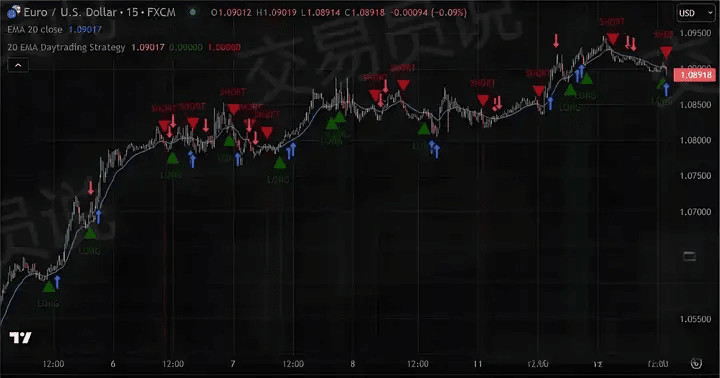
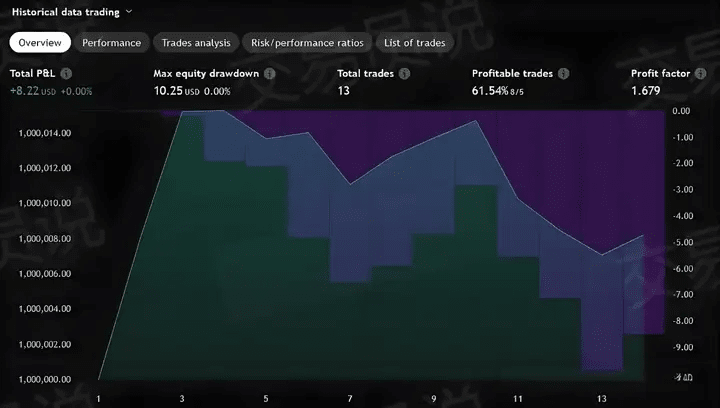
A total of 13 trades were conducted in 7 days, validating the value of the 20EMA strategy as an intraday trading system.
Conclusion
The 20EMA trading strategy is a simple yet powerful strategy. Compared to SMA (Simple Moving Average), EMA (Exponential Moving Average) is closer to price fluctuations, thereby displaying a more accurate 'rebound line' on the chart.
This strategy is simple enough for even novice traders to quickly get started and is quite effective for short-term trading on the 15-minute chart. But remember, it is best to first confirm the trend on the daily chart and pay attention to support and resistance areas.
Even if the 20EMA strategy may fail at times, you can improve your win rate by analyzing multiple time frames and adding more tools to your chart. Moreover, if you trade in the direction of the major trend confirmed on the daily chart, the overall probability of profit remains high.
While it may take some time to fully master this approach, it is indeed worth trying. More importantly, you should first test this strategy on a forex demo account before applying it to a live account.
Finally, here’s a set of valuable insights! The next 7 iron rules I will share should be firmly remembered and truly integrated into practice.
—.
1. Do your homework and understand the market.
To avoid losses, the most important step is to thoroughly understand the cryptocurrency market. There are many types of cryptocurrencies, each with different technical backgrounds, application scenarios, and market performances. Always conduct in-depth research on the cryptocurrencies you are interested in before investing.
Technical Analysis: By learning technical analysis tools such as candlestick charts, moving averages (MA), and the Relative Strength Index (RSI), you can help determine market trends.
Fundamental analysis: Understand the project background, team strength, application prospects, etc., of the cryptocurrency to ensure that the project you invest in has long-term value.
Pay attention to news and market sentiment: The cryptocurrency market is highly sensitive to news, regulatory changes, and policy shifts. Mastering this information can help you make more informed decisions.
2. Control emotions; do not blindly follow the crowd.
The cryptocurrency market is extremely volatile, and significant price fluctuations often tempt investors to make emotional decisions. It is crucial to avoid following the crowd during market euphoria or panic.
Avoid FOMO (Fear of Missing Out): When the market rises, many people rush to buy out of fear of missing out on an opportunity. Do not blindly follow market euphoria; stay calm and analyze whether there is excessive speculation in the market.
Stay calm in the face of declines: When the market falls, do not rush to sell, especially without clear analysis. Holding quality projects for the long term may yield profits in future rebounds.
3. Reasonably allocate assets; do not put all your eggs in one basket.
"Don't put all your eggs in one basket" is the golden rule of investing, especially in the high-risk cryptocurrency market. Asset allocation and diversification are very important.
Diversify investments: Choose multiple cryptocurrencies for investment to avoid putting all your funds into one cryptocurrency. If one cryptocurrency performs poorly, the performance of others may compensate for your losses.
Keep some cash: Holding a certain proportion of cash (such as USDT or other stablecoins) during significant market declines allows you to take advantage of buying at lower prices.
4. Set stop-loss and take-profit strategies.
In a highly volatile market, a reasonable stop-loss and take-profit strategy is key to protecting yourself from significant losses.
Set stop-loss levels: For each trade, set a stop-loss level according to your risk tolerance. If the price reaches this level, the position will close automatically to avoid larger losses.
Regularly lock in profits: When you gain a certain profit, promptly lock in some profits. Avoid greedily waiting for higher profits and missing good opportunities. By regularly taking profits, you can ensure a certain level of gain and prevent losses due to market pullbacks.
5. Learn to combine long-term investment and short-term trading.
The volatility characteristics of the cryptocurrency market make it possible to obtain high returns in the short term, but it also comes with significant risks. Therefore, combining long-term investments with short-term trading strategies can help reduce risks.
Long-term investment in quality cryptocurrencies: Choose those with technological innovation, strong teams, and application prospects for long-term holding, such as Bitcoin (BTC) and Ethereum (ETH). These types of cryptocurrencies have stood the test of time and are more suitable for long-term investment.
Conduct short-term trading cautiously: Although short-term trading (such as contract trading) can amplify profits, it can also amplify losses. If you lack rich market experience and technical analysis skills, try to minimize high-leverage short-term operations.
6. Learn risk management to reduce risk exposure.
The most important point in trading cryptocurrency is to always control risk, ensuring that the potential loss of each trade is within an acceptable range.
Small investments: Only invest a small portion of your total capital in each trade to avoid being unable to cope with unexpected situations.
Maintain a safety margin: Avoid excessive leveraged trading, especially in highly volatile markets, as high leverage significantly increases your risk of loss.
7. Keep learning and continuously follow market dynamics.
The cryptocurrency market changes rapidly, with new technologies, regulations, and projects constantly emerging. Keeping up with continuous learning and updates can help you stay competitive in the market.
Learn industry knowledge: By learning more about emerging fields such as blockchain technology, DeFi (Decentralized Finance), and NFTs (Non-Fungible Tokens), enhance your understanding of the industry.
The cryptocurrency trading market is full of opportunities and risks, but by deeply learning market knowledge, staying calm and rational, allocating assets reasonably, setting stop-loss and take-profit levels, combining long and short-term strategies, and strictly controlling risk, you can effectively avoid losses and maximize the protection of your investments. Most importantly, always remain vigilant to avoid emotional trading and ensure that your invested assets match your risk tolerance.
If everyone can stick to these 7 iron rules in the cryptocurrency space, I believe you can definitely defeat 90% of the people in the market. That's all for today's content; in practice, make sure to apply and summarize more to thrive in the cryptocurrency market.
Don't get lost anymore! If you want to steadily grow, skyrocket, or make a comeback, follow my trading method!
I set the pace, choose the cryptocurrencies, and determine the direction, providing 2-5 strong signals daily with precise tips!
Stop relying on feelings to trade; we achieve results through discipline and strategy!
